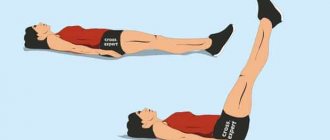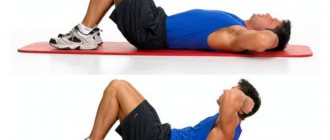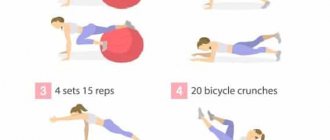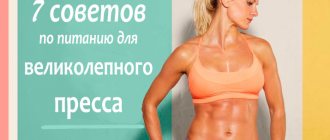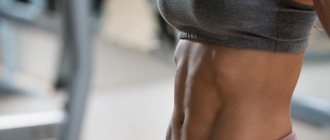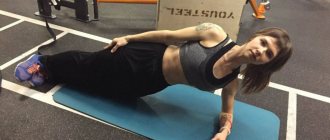If you spent the last six months in bars, burger joints and other burping joints, building up fat folds for thermal purposes, then we know what will happen in a month and a half. You will come to the beach, take off your shirt, and everyone will close their eyes in horror. But it's not too late to fix everything! Read our detailed guide on how to pump up your abs: at home, on the street, in the gym. Yes, an important note: if the cubes have already begun a dance around your navel, and you not only wash down yohimbine with clenbuterol, but also have a rough idea of why you are doing this, then scroll on - you are unlikely to discover anything new.
Abs start in the kitchen
The saying about “70% of abs is done in the kitchen”, in general, is not a saying at all, but a truth cast in granite. The abdominal muscles are perhaps the most dependent on fat deposits. Historically, the lower abdomen accumulates the most strategic reserves, which the body aims to use in lean years. And since people, for the most part, left the cave a relatively long time ago, hunger still does not occur. But your body doesn’t realize that there’s a McDonald’s and a couple of shawarma shops across the street from you, so you no longer need to replenish the storage space around your waist. So you can endlessly hold a plank, do crunches and die on a Roman chair, but nothing will help you: no one, even the most pumped up abs, has ever coped with a ten-centimeter pillow on his stomach. You might as well buy a Maserati and put it in your grandfather's shell garage. So I’m sorry, but you’ll read about the abs themselves a little later, but for now let’s talk about nutrition.
Proper nutrition while pumping abs at home
The waist is a problem area where excess fat often accumulates. A layer of fatty tissue can cover pumped up perfect abs. Poor nutrition becomes the reason that training does not bring “visible” results in the form of pads.
Nutrition Basics: Calories
The diet is based on vegetables and white meats. Simple carbohydrates and foods with a high glycemic index are excluded. Multiplicity of meals – 3 main meals and 3 snacks. Every meal should include a source of protein. It is better not to limit yourself to counting nutritional supplements and calories, but also take into account vitamins and minerals when creating a menu.
To prevent the formation of fat deposits, you must strictly adhere to the recommended calorie intake. Tables and applications have been developed to calculate menu calories. When losing weight, the number of calories consumed should be lower than the number expended. In other cases, caloric intake depends on the intensity of training, type of diet (weight, cutting, etc.), age, gender and professional activity.
Squirrels
Proteins are needed to build new muscle fibers. The proportion of proteins in the diet should be at least 30%. List of healthy foods that contain protein:
» Chicken or turkey meat; " Beef; " Shrimps; » Salmon, pink salmon or salmon; " Eggs; » Tuna; » Almond and coconut milk; » Nuts; » Legumes: beans, chickpeas, peas, soybeans.
Fats
Fats are required for the absorption of large amounts of vitamins and minerals, as well as providing cells with energy. List of foods containing healthy fats:
" Olive oil; " Butter; " Milk; » Flaxseed, pumpkin, almond oils; » Nuts; " Pumpkin seeds; " Sea fish.
Carbohydrates
It is useful to include slow carbohydrates in the diet, the amount of which should be 30-60% of the diet. Healthy foods:
" Buckwheat; " Rice; " Oatmeal; » Quinoa; » Green vegetables.
Water, fruits and vitamins
To absorb all substances and maintain cells in a functional state, it is imperative to replenish water supplies. It is recommended to drink at least 2.5 liters of clean water per day. Tea, coffee and other drinks are counted as food products.
It is recommended to consume all fruits and berries in the first half of the day, as they contain large amounts of fructose and glucose - sugars. The amount of simple carbohydrates in the diet should not exceed 15%.
When creating a menu, it is recommended to take into account the minerals and vitamins included in the products. Vitamins are needed to maintain healthy joints, bones and muscles, stable blood supply and nutrition of tissues. Multivitamin complexes are ideal for replenishing deficiencies.
Somatotype
First of all, you need to find out what body type you are. There are three of them: endomorphic, mesomorphic and ectomorphic. If you are a mesomorph, then a) endomorphs and ectomorphs hate you, b) it’s easy for you to lose weight, gain weight, gain weight and lose it. Right now, thank God (or whoever you believe in) for such a somatotype - you are lucky.
If you are tall, thin, and since school days you have not been offended when people call you a scumbag, then you are an ectomorph. You won't be successful in weightlifting, but it won't be difficult to show off your six-pack to your classmates - you have minimal fat. Most likely, your abs are already visible - they are just underdeveloped and therefore look funny. But if you try... remember Brad Pitt's torso from Fight Club?
Finally, if you are thick, wide and have forgotten when you weighed less than 80 kg, then you are an endomorph. You should be great at manipulating the barbell, but the problem is with your abs. You will be able to collect a sixpack, but it will have nothing in common with the magnificence of, say, Cristiano Ronaldo. However, don’t despair - Gerard Butler is also an endomorph, which didn’t stop him from sparkling with Zack Snyder’s six-pack.
If you still can't decide, measure your wrist. For an ectomorph, the bone will be less than 17 cm, for a mesomorph - within 17-20 cm, for an endomorph - more than 20 cm. But do not forget that the pure type is rare: neighboring figures are usually mixed.
Auxiliary tools for perfect abs
To increase the effectiveness or intensity of exercises, it is recommended to use auxiliary equipment:
» Gymnastic mat. » Dumbbells, plates and barbell. » Rubber bands. " Video clip. » Bars and crossbars. » Bench. " Hula Hup. » Fitball and hemisphere balance.
Should I do cardio?
Cardio exercises complement the main set of exercises, but do not serve as an alternative. Running, cycling, aerobics, swimming and various martial arts help burn calories and lose weight. Cardio training will help improve the tone of all muscles.
The benefits of the Plank exercise
“Plank” is a static type of load that helps to pump up the six-pack abs.
Technique variations:
» Two points of support; » Reverse “Plank”; » Jumping; » Raising a leg or arm; » "Mountaineer"; " "Spider".
Measuring progress: training diary, before and after photos
» Measure and record your waist circumference. » Take a photo of yourself in the mirror from the front, sides and back. Choose clothes so that they fully reveal your stomach. Do not spare your own feelings and choose a mirror under a bright light source. » Write down your desired goals on the first page of your diary. Break the plan for achieving results into several stages and track the dynamics of changes. “Be sure to write down the menu, frequency of sets and repetitions, rest days, cheat meals and other details in your diary. » After the deadline, take a photo of yourself again from all sides, measure your waist circumference and compare the original data with the desired result. » Draw conclusions for the future to improve the quality of training.
Myths about the press
» There are upper and lower segments of the press. From the ribs to the pubic symphysis, the press is formed by the rectus muscle, the fibers of which contract equally when loaded. » When swinging your legs, the iliopsoas muscle also works. » It’s easier for men to pump up their abs. The average amount of fat in men is 15%, and in women - 20%. The cubes are visible when this indicator is reduced to 10%. “If you work only on your abs, the fat will disappear from your waist. There are no exercises that can help you remove fat from any specific segment. Intense training reduces the percentage of fat throughout the body, not just in specific areas. » You can pump up your abs to six-pack abs in 10 minutes a day. To pump up muscles and draw relief, you need to exercise hard and for a long time. Don't expect quick results.
Author: ForceMan from 07/31/2018, 19:37
- 4
Food
Describing all kinds of diets here is a pointless exercise, so we will limit ourselves to introductory information. Firstly, under no circumstances rush to extremes. Sitting on kefir and the smell of cheese for a week is not worth it - it is not only dangerous, but also pointless: the body will think that you are about to die and will begin to frantically eat your muscles. And only then will he switch to fat, but will consume it one teaspoon a day. That is why all sorts of diets in the spirit of “don’t eat after six” work mainly with hundred-kilogram ladies.
So you need to eat, and even more often than usual. But less: eat half (and quarter) portions five to six times a day, this will force your body to constantly work and, as a result, burn more calories. After all, any weight loss one way or another comes down to one thing - burning more calories than you consume. And also pay attention to carbohydrates: they should not be more than 40% of the total amount of substances received in the diet. And if you have decent willpower, then it’s ideal to consume two grams of carbohydrates per kilogram of weight per day. Of course, we are talking about slow carbohydrates - cereals, brown rice, lentils, buckwheat, and so on. Put off the buns, chocolate and beer until winter.
To make life less boring, eat more protein. Eat boiled (not fried!) chicken, low-fat fish, low-fat cottage cheese and kefir. You can compensate for the lack of sugar with fruits, but look for yourself: professional athletes even refuse this when losing weight.
The most effective exercises for training the abs
There are only two of them in several variations:
- twisting (on any flat surface, on a fitball, on an inclined bench, on a Roman chair without fixing the legs);
- reverse crunches (on a flat surface lying on your back, on a Roman chair, parallel bars or hanging).
Moreover, any of them forces the entire abs to work, and not the lower and upper abs separately. Anatomically, it is a single muscle, the tuberous appearance of which is formed by tendon constrictions. The difference between the exercises is only in the emphasis - in the first case there is more tension in the upper part of the rectus muscle, in the second - in the lower part.
The name of the exercises reveals their essence - you must TWIST! Imagine curling up into a ball while doing this, with your back rounded. The range of motion is short, keep your hands in front of you when doing crunches. In no case behind the head, since people in this position instinctively begin to pull themselves by the head, trying to facilitate movement, which is fraught with injuries to the cervical spine.
When performing reverse hanging crunches, your legs are bent at the knees and raised so that the angle between the thigh and abdomen is 90°. Next, raise your bent legs up to your chest, again, twisting.
What happens if you lift your torso straight in crunches with an arched lower back, or if you rise too high? You don’t strain your abs, but your hamstrings , partially your quadriceps , and your iliopsoas muscle . The last point is especially dangerous, since the spine is loaded too much, which can lead to injuries (protrusion and even hernia), not to mention muscle pain and “clogged” back (it’s a “stake”).
Raising your legs straight in reverse crunches, you, similarly, strain your hips and iliopsoas muscles, overloading the spine and placing too little pressure on the abs directly.
Errors in movements during abdominal training are clearly and clearly shown in this video:
As for the technique of performing the exercise, I recommend paying attention to the video by Yaroslav Brin (9:30 - crunches, reverse crunches on the bench - 18:15):
In the living room
Okay, let's leave your refrigerator alone. But the theory is not finished yet! Let's figure out what the abdominal muscle actually is. Contrary to popular belief, it is not “lower abs” and “upper abs”. This is a flat, long abdominal muscle whose job is to twist your body in the pelvic spine. Next to her is a colleague - the oblique abdominal muscle. It is this thing, in combination with the lower part of the rectus muscle, that is responsible for the Adonis belt, which attracts the gaze of all surrounding females (and often males). Putting on a belt is more difficult than gaining cubes, so immediately prepare for adversity and hardship. There are other types of abs in your cunning body, see the picture:
Is it necessary to specifically pump up the oblique abdominal muscles?
No no need. They get enough load during basic exercises such as back squats, deadlifts, deadlifts, military presses, and other movements where the body needs to be stabilized under weight. Under these same conditions, the abs and back extensors are very significantly loaded.
The only condition is to try not to use a weightlifting belt on light and medium weights, when you are still able to retract and control your stomach. The belt is only worn when controlling the stomach becomes problematic and it simply falls out. In my case, these are squats with a weight of more than 120-125 kg and deadlifts with a weight of more than 140 kg.
Workouts and abs
The lecture is over, let's move on to what you came for, training. Let's take the worst case scenario: you spent the money for a gym membership on upgrading your computer for QuantumBreak, and in the courtyard of your house, of all the sports equipment, there is only a rickety table on which local grandfathers play dominoes. Don't despair. The abs are almost the only muscle that can really be pumped up at home (pumped up, not made into a godlike form, gentlemen commentators). There are many programs and exercises for the abdominal muscles, and we have prepared a description of five effective exercises.
Training programs
To properly pump up your abs, you need to adhere to a specific training plan. For girls who are just starting to work on their abdominal muscles, it is advisable to use a seven-day training cycle. It allows you to quickly tone the muscle corset around the waist and master the technique of performing exercises.
Table: set of exercises for the week
| Day of the week | Exercises |
| Monday | Lying leg raises + V-shaped body raises + side lying body raises |
| Tuesday | Scissors + classic sit-ups + side crunches |
| Wednesday | Day off from training |
| Thursday | Bicycle + roller exercise + side plank pelvic lift |
| Friday | Raising the legs while hanging on the horizontal bar + fold + bending to the sides in a lying position |
| Saturday | Reverse crunches + exercise ball crunches + plank crunches |
| Sunday | Day off from training |
Starting next Monday, the training cycle must begin again.
For girls who already have experience in strength training and an initial level of physical fitness, a training cycle lasting a month is suitable. A special feature of this plan is rare and powerful loads with an emphasis on a specific area of the press in each workout. This approach allows you to create a high level of stress in the abdominal muscles and start the process of their hypertrophy (growth).
Table: abdominal training for 30 days
| Number | Exercises | Number | Exercises |
| 1 |
| 18 |
|
| 6 |
| 24 |
|
| 12 |
| 30 |
|
On days off from dynamic abdominal training, you need to add a vacuum exercise. It will help you quickly get rid of fat deposits in the waist area and make it narrower.
Girls who pump up their abdominal muscles in order to have beautiful, sculpted abs should keep in mind that training alone will not achieve results. Success in this case also depends on nutrition. The diet should be low-carbohydrate, and the food intake should be fractional (food enters the body in small portions every 2-3 hours). Only if these conditions are met is it possible to quickly pump up your abs.
- Author: Author: Alena
Rate this article:
- 5
- 4
- 3
- 2
- 1
(16 votes, average: 4.1 out of 5)
Share with your friends!
Roller crunches
You take out 500-1000 rubles from your stash. You go to the website of a sports store. You buy a gymnastic roller - a spinning thing with two handles on the sides. You find two free meters in length in your Khrushchev apartment. You place the roller on the floor, resting your hands on it. Roll the roller forward until your torso is close to the floor. You return to your place. After three repetitions, you will feel pain like never before. In five, you’ll think you’re about to give birth. In ten, you’ll collapse on the linoleum, and you’ll walk crouched for a week. This option is for working the rectus muscle, although there is a modification with horizontal repetitions. But if you've just started, it's better not to. Seriously.
"Bike"
According to some research, the most effective abdominal exercise. The point is this. Lie down on a gymnastics mat or pre-vacuumed carpet. Hands behind head. Bend your knees at an angle of 45 degrees. And you begin to alternately pull your elbow to your knee. Mirror - right elbow to the left knee, left, respectively, to the right. Unlike the ordeal of using a roller, you can use a “bicycle” to work out the oblique muscles painlessly. Good luck.
Schedule and set of abdominal exercises at home
First, a little about the structure of the abdominal muscles. The abdominal cavity includes: the outer layer - the rectus and oblique external abdominal muscles; deep layer - transverse and oblique internal abdominal muscles.
For the harmonious development of the abs, it is important to train each muscle group. And depending on how much you want to develop your abs, your training schedule will be structured differently. Below we will consider options for various purposes and degrees of load intensity.
Scheme of performing abdominal exercises for beginners
The next complex is suitable for those who are starting classes from scratch. The abdominal training schedule is based on the following scheme: 3 times a week, with 1-2 days rest between workouts. For example: Monday, Wednesday, Friday. Or Tuesday, Thursday, Saturday.
Day #1
| Full crunches . The exercise is performed lying on your back. For convenience, you can fix your feet and keep your hands on your chest. The athlete’s task is to lift the torso off the floor with a round back, bringing the stomach closer to the hips, and slowly lower to the floor. |
| Lying leg raises . The athlete lies on the floor, placing his hands under his pelvis for stability, and keeping his legs vertical. As you inhale, lower your legs, aiming your heels towards the floor, and as you exhale, return to the starting position. It is important not to lift your lower back off the floor. |
| Bicycle crunches . To perform crunches, you need to place your hands behind your head, lift your shoulder blades off, and hold your legs above the floor at a 45-degree angle. With an exhalation, the athlete twists the torso diagonally, while bringing the knee to the opposite elbow. As you inhale, the athlete changes position and exhales to twist in the other direction. And so the movement is repeated without pauses, without touching the floor with your shoulder blades and feet throughout the entire approach. |
Each exercise is performed for 15-25 repetitions of 2-3 approaches. Those who find the complex easy can perform the exercises one after another without rest. At the end of the cycle, you can rest for 2 minutes, then perform the complex 1-2 more times.
Day #2
| Plank in statics . The exercise tones the deep transverse muscle, without the development of which it is impossible to get strong and strong abs. The plank can be performed both on straight arms and on the forearms. The main thing is to keep the body in an ideal position, in which the back and hips remain in a straight line. The press in this position should always be tense. |
| Side plank . In this version, the athlete turns diagonally from the plank and rests on one hand and both feet, keeping the body line straight. The same is done on the other side. |
| Extension steps in plank . Standing in a plank position, the athlete takes steps with one foot to the side, placing the second one against it, and also takes a reverse step, alternately rearranging the feet. At the same time, the spine remains straight. |
All exercises are performed for 30-60 seconds without changing technique, 2-3 approaches each. You can rest for 30-60 seconds between planks.
Day #3
| Short crunches . These twists are performed at half amplitude: hands are placed behind the head, feet rest on the floor. As you exhale, the athlete lifts his shoulder blades off the floor and reaches his chin toward the ceiling, and as he exhales, he lowers himself to the floor. |
| Raising the pelvis from the floor . Lying on the floor, the athlete raises his legs vertically and places his arms along his body. With an exhalation, a short and sharp movement pushes the pelvis up using the lower part of the abs and lifts the lower back off the floor. As you exhale, slowly lower your pelvis to the floor. |
| Oblique twists . To perform lateral twists, the athlete, lying on his back, places one arm behind his head, bends the opposite leg at the knee and rests the ankle on the thigh of the supporting leg, bent at the knee. He extends his other hand to the side. With an exhalation, a diagonal twist is performed, while the elbow, when lifting the shoulder blade off the floor, tends to the opposite knee. As you inhale, the torso returns to the floor. The same is done on the other side. |
All exercises are performed for 15-25 repetitions of 2-3 approaches.
Scheme for abs for 30 days: chart in table
This program is performed one approach at a time every day. If you only have a few minutes at your disposal, this program will be the best option. On a certain day, except for the rest day, regular crunches are performed lying on the floor for the specified number of repetitions.
| Day | Number of repetitions |
| 1 | 15 |
| 2 | Day of rest |
| 3 | 20 |
| 4 | Day of rest |
| 5 | 25 |
| 6 | Day of rest |
| 7 | 30 |
| 8 | Day of rest |
| 9 | 25 |
| 10 | Day of rest |
| 11 | 35 |
| 12 | Day of rest |
| 13 | 30 |
| 14 | Day of rest |
| 15 | 40 |
| 16 | Day of rest |
| 17 | 35 |
| 18 | Day of rest |
| 19 | 45 |
| 20 | Day of rest |
| 21 | 40 |
| 22 | Day of rest |
| 23 | 50 |
| 24 | Day of rest |
| 25 | 45 |
| 26 | Day of rest |
| 27 | 55 |
| 28 | Day of rest |
| 29 | 60 |
| 30 | Day of rest |
Abs for beginners: plank fulfillment table for a month
The plank is a universal exercise not only for developing the abs, but also the whole body. The exercise allows you to work the deepest stabilizer muscles, improve posture, lose weight, and tighten the muscles of the whole body.
| Day | Holding time, sec. |
| 1 | 20 |
| 2 | 20 |
| 3 | 30 |
| 4 | 30 |
| 5 | 40 |
| 6 | 40 |
| 7 | Day of rest |
| 8 | 50 |
| 9 | 50 |
| 10 | 60 |
| 11 | 60 |
| 12 | 90 |
| 13 | 90 |
| 14 | Day of rest |
| 15 | 120 |
| 16 | 120 |
| 17 | 150 |
| 18 | 150 |
| 19 | 180 |
| 20 | 180 |
| 21 | Day of rest |
| 22 | 210 |
| 23 | 210 |
| 24 | 240 |
| 25 | 240 |
| 26 | 270 |
| 27 | 270 |
| 28 | Day of rest |
| 29 | 300 |
| 30 | 300 |
Abs program at home for advanced people
The following program is aimed at strengthening the abdominal muscles. To increase the load, use additional equipment in the form of dumbbells, weighted disks, rubber bands, etc. The complex is performed three times a week. Do not perform the workout several days in a row, as the muscles can easily become overworked.
- Fold.
- Leg lift.
- Oblique twists.
- Short crunches.
- Plank running (Climber).
Each exercise is performed for 30 seconds one after another without a pause.
At the end of the cycle, a two-minute rest is performed and another 2-3 cycles are repeated. At the end of the program, do not forget to stretch your abdominal muscles. To do this, lie on your stomach, push your hands off the floor, straightening them at the elbows, and lift your stomach off the floor, stretching your abdominal muscles. And another program for effectively pumping up the press from Igor Voitenko:
PRESS PUMPING. Wild Burning in 6 MINUTES.
Hanging Leg Raise
Here you will need some kind of brace for your upper limbs. A horizontal bar made by you in a short-term impulse for self-improvement is perfect. So, hold on to the horizontal bar, bend your knees and slowly raise your knees to your chest, while simultaneously engaging your pelvis. Having reached the peak, you hold it for several seconds. And just as slowly you lower it back. If you are swaying, ask someone to hold you - let them rest on your back. If you feel strong, you don’t have to bend your knees. The transverse muscles are involved in the work in any case, but you can additionally influence them by “throwing” your side in one direction or another. Then it will hurt. Strongly.
Side plank
The regular plank is a good exercise, but rather for a general range of muscles. But the side one greatly increases your chances of someday getting a belt. Lie down on your left side, with your left arm extended and resting on the floor. Raise your legs and pelvis, but without spreading your feet. You extend your right hand. You tense all the muscles you can. You freeze for 15-30 seconds. You change sides.

